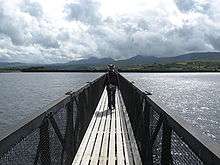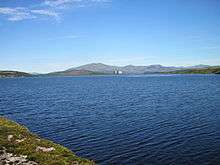Llyn Trawsfynydd
Llyn Trawsfynydd is a large man-made reservoir situated near the village of Trawsfynydd in Gwynedd, North Wales. With a total surface area of 4.8 km² (1,180 acres) the reservoir is slightly more extensive than Wales's largest natural lake, Bala Lake (which covers an area of 4.5 km²).
| Llyn Trawsfynydd | |
|---|---|
Looking south | |
| Location | Gwynedd, North Wales |
| Coordinates | 52°54′40″N 3°56′40″W |
| Type | reservoir |
| Primary outflows | Afon Prysor |
| Built | 1928 |
| Max. length | 4.39 km (2.73 mi) |
| Max. width | 2.3 km (1.4 mi) |
| Surface area | 4.8 km2 (1.9 sq mi) |
| Average depth | 4 m (13 ft) |
| Water volume | 40,390,000 m3 (1.426×109 cu ft) |
History


The large man-made reservoir was created between 1924 and 1928 by building four dams. Its purpose was to supply water for Maentwrog hydro-electric power station.
Although two dozen properties, some of historical significance, were lost in the creation of the lake, there was little local objection at the time. Indeed, the power station was regarded as a good thing because it was capable of supplying the whole of North Wales' electricity needs. However local landowners and farmers did object to the loss of rights of way across their former lands. In order to negate long detours round the new lake, a small road was built along the western shore and a footbridge was erected across the narrowest part of the lake.
In 1965 the reservoir became the source for cooling water for the Trawsfynydd nuclear power station which began generating electricity for the UK National Grid. In respect to this new role, one of the lake's dams was rebuilt in the early 1960s to increase the volume of Llyn Trawsfynydd. This was because of priority over usage. Whereas previously the Maentwrog power station had taken all of the water in the lake, the needs of the nuclear plant dictated that the hydro plant would only be able to utilise the top 5 ft (1.5 m) of water.
In 1991 the nuclear power station was shut down. It is now in the process of decommissioning. Work will be completed in 2083.[1]
Since the plant's closure, the lake's water temperature has cooled to natural levels allowing fauna and flora to regenerate. Water continues to be used for hydroelectricity generation.
Notes
- "Trawsfynydd". magnoxsites.co.uk. Magnox. Archived from the original on 3 April 2015. Retrieved 20 June 2015.